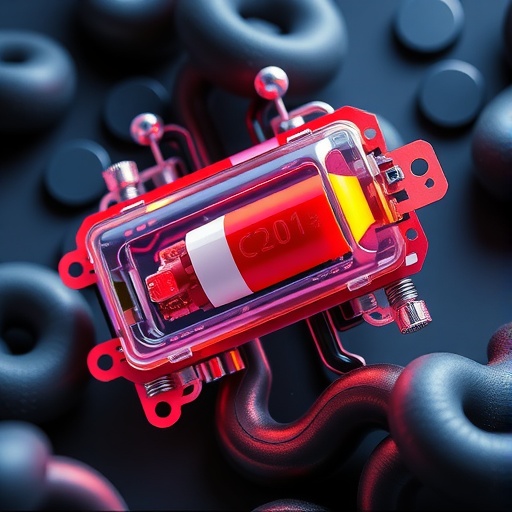In a groundbreaking advancement in the realm of sustainable energy storage, researchers have unveiled a novel glucose flow cell battery powered by vitamin B2, commonly known as riboflavin, and glucose. Drawing inspiration from the way human metabolism efficiently breaks down glucose to release energy, the scientific team has ingeniously integrated riboflavin into a prototype flow battery design. This innovative approach positions riboflavin as a vital electron shuttle, facilitating the transfer of electrons between the electrodes and the glucose electrolyte. Through this mechanism, the battery harnesses and converts the chemical energy stored within sugar molecules into an electrical flow, pioneering a fresh avenue for bio-derived energy solutions.
The core strength of this riboflavin-glucose flow cell lies in its utilization of abundant, environmentally benign materials. According to lead researcher Jong-Hwa Shon, this technology offers a compelling vision for developing residential energy storage systems that are safer, affordable, and sustainable. Unlike traditional energy storage devices relying on rare, expensive metals, this system employs non-toxic constituents readily available in nature. This integration of biochemically inspired components advances the goal of democratizing energy storage, aligning with global efforts to reduce reliance on critical metal supply chains while addressing environmental concerns associated with conventional battery chemistries.
Fundamentally, flow cell batteries operate by storing energy in liquid electrolytes that flow through the cell’s chambers, undergoing reversible electrochemical reactions that transform stored chemical potential into electric power, and vice versa. Glucose, ubiquitous in plants and easily sourced from biomass, emerges as an attractive candidate as a sustainable, low-cost energy carrier in these systems. However, traditional glucose fuel cells typically depend on noble metal catalysts—such as platinum—that are not only expensive but also challenging to scale industrially. These catalysts often yield limited power and pose significant manufacturing constraints, hindering practical applications.
In contrast, riboflavin presents a stable and efficient catalytic alternative in aqueous alkaline environments typical of flow cell electrolytes. Its stability under basic pH conditions and ability to mediate electron transfer without metal inclusion render it an ideal biological mediator in these settings. The research team, including Ruozhu Feng and Wei Wang, hypothesized that incorporating riboflavin as a catalyst could overcome existing limitations in glucose fuel cells, creating a scalable and metal-free solution capable of enhanced power generation.
The experimental setup employed carbon materials as electrodes for both the anodic and cathodic sides of the battery. The negative electrode was bathed in an electrolyte containing riboflavin in its active redox state alongside glucose, enabling electron mediation within this environment. Meanwhile, the positive electrode’s electrolyte comprised either potassium ferricyanide or molecular oxygen in aqueous solution maintained at basic pH levels. Potassium ferricyanide allowed precise quantification of riboflavin’s catalytic performance, while oxygen offered a more economically viable option for future large-scale implementations, aligning with green energy production goals.
Notably, when powered by potassium ferricyanide, the prototype exhibited electron transfer rates and power densities at room temperature that rival those observed in vanadium-based flow batteries, the current industrial benchmark. These results suggest that riboflavin effectively substitutes for costly metal catalysts without sacrificing performance, marking a seminal achievement in bio-inspired energy storage technologies. The flow cell utilizing oxygen as the cathodic reactant, though displaying slower electrode kinetics, still surpassed previously reported glucose battery performances, underscoring its potential when further technological refinements are applied.
A challenge intrinsic to the oxygen-based system arises from photodegradation phenomena, whereby exposure to light catalyzes riboflavin breakdown, thus inducing self-discharge effects that lower battery efficiency. The research team intends to mitigate these drawbacks through chemical stabilization strategies and advanced cell engineering to shield riboflavin from photolytic damage, thereby enhancing the longevity of oxygen-driven flow cells. These innovations could unlock the full practical potential of bio-derived glucose batteries, facilitating their deployment in grid-scale and residential energy storage platforms.
This glucose-riboflavin flow battery holds profound implications for the renewable energy landscape. By tapping into metabolic-like pathways to convert commonplace biological molecules into electric power, it represents an intersection of biotechnology and electrochemistry that aligns with ecologically conscious energy paradigms. Its cost-effectiveness and environmental friendliness pave the way for further development of biomimetic energy devices, contributing to an energy transition that prioritizes sustainability without compromising technological performance.
The research was supported by the Energy Storage Research Alliance and the U.S. Department of Energy’s Energy Innovation Hub, highlighting the strategic importance and collaborative nature of this endeavor. Additionally, funding from the Energy Storage Materials Initiative at Pacific Northwest National Laboratory played a vital role in the initial ideation and experimental investigation of this promising flow cell design. These partnerships illustrate the increasing convergence of governmental research initiatives with academic innovation to accelerate breakthroughs in sustainable energy technologies.
As the team continues to optimize both chemical stability and cell design, anticipated improvements in power density and operational durability could position this battery as a competitive alternative in the expanding field of electrochemical energy storage. The prospect of integrating such green batteries into renewable energy grids offers a practical solution to the intermittency challenge of solar and wind power, thereby fostering a more resilient and environmentally responsible energy infrastructure.
This vitamin-mediated glucose flow battery signifies a paradigm shift—moving away from traditional metallic catalysts to harnessing nature’s own molecular machinery for electricity generation. It underscores the potential of combining biochemical inspirations with electrochemical engineering to cultivate new classes of batteries that are both high-performing and ecologically sound. As the world demands cleaner and more affordable energy solutions, this pioneering technology may well mark a turning point in how sustainable power is generated and stored.
Subject of Research: Glucose flow cell battery catalyzed by riboflavin for sustainable electrical energy generation
Article Title: Vitamin-Mediated Glucose Flow Cell for Sustainable Power Generation
News Publication Date: 15-Oct-2025
Web References: http://dx.doi.org/10.1021/acsenergylett.5c02462
References: ACS Energy Letters, 2025, DOI: 10.1021/acsenergylett.5c02462
Image Credits: Nathan Johnson, Adapted from ACS Energy Letters 2025
Keywords: Chemistry, Batteries, Electrochemistry, Energy
Tags: alternatives to rare metal batteriesbio-inspired energy storagedemocratizing energy accesseco-friendly battery materialsenvironmentally friendly power sourcesglucose flow cell batteryhuman metabolism-inspired technologynon-toxic energy storage systemsrenewable energy researchresidential energy storage innovationsriboflavin as electron shuttlesustainable energy solutions





